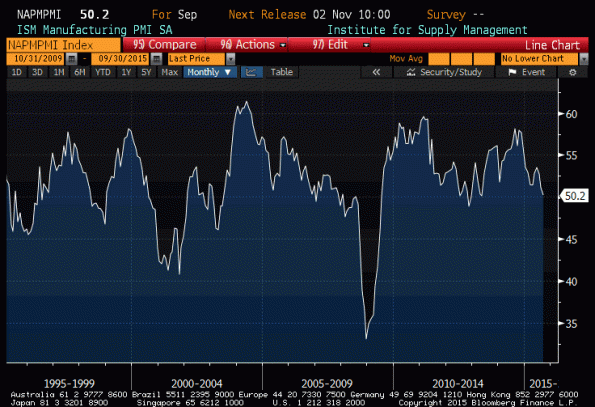Yesterday, I mentioned the likelihood that a recession is coming. The indicators for this are mostly from the manufacturing side of the economic ledger, and they are at this point merely suggestive. For example, the ISM Manufacturing Index is at 50.2, below which level we often see deeper downdrafts (see chart, source Bloomberg).

Capacity Utilization, which never got back to the level over 80% that historically worries the Fed about inflation, has been slipping back again (see chart, source Bloomberg).

Now, we have to be a bit careful of these “classic” indicators because of the increased weight of mining and exploration in GDP compared with the last few cycles. A good part of the downturn in Capacity Utilization, I suspect, could be traced to weakness in the oil patch. But at the same time, we cannot blithely dismiss the manufacturing weakness as being “all about oil” in the same way that Clinton supporters once dismissed Oval Office shenanigans as being “all about sex.” Oil matters, in this economy. In fact, I would go so far as to say that while historically a declining oil price was a boon to the nation as a whole (which is why we never suffered much from the Asian Contagion: the plunge in commodity prices tended to support the U.S., which is generally a net consumer of resources), in this cycle low oil prices are probably neutral at best, and may even be contractionary for the country as a whole.
Whether we have a recession in the near term (meaning beginning in the next six months or so) or further in the future, here is one point that is important to make. It will not be a “garden variety” recession, in all likelihood. That is not because we have boomed so much, but because we are levered so much. There are no more “garden variety” recessions.
Financial leverage in an economy, just as in individual businesses, increases economic volatility. So does operational leverage (which means: deploying fixed capital rather than variable inputs such as labor – technology, typically). And our economy has both in spades. The chart below (source: Bloomberg) shows the debt of domestic businesses as a percentage of GDP. Businesses are currently more levered than they were in 2007, both in raw debt figures and as a percentage of GDP.



